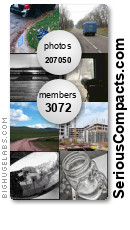Pt. 1 - Appearance and Zoom Range
Pt. 2 - JPEG Noise
Pt. 3 - ISO 80 JPEG Crops at 35mm & Full Aperture
Pt. 4 - Flare Performance
Pt. 5 - Noise Performance Revisited
Pt. 6 - G7 Default JPEG vs GX100 Silkypix Conversions
Pt. 7 - Key Timings
Pt. 8 - Build Quality, Quality Control, and Battery Life
Pt. 9 - Conclusion
In order to evaluate the flare performance of these three cameras, I took a series of photos with a strong indirect light source. In this case, I took a photograph of the shadowed side of a house where just above the frame there was strong light coming from a very bright, overcast sky.
Settings:
- JPEGs were compared. For the Leica and Ricoh cameras, I actually shot using the RAW+JPEG setting, but the crops you see are from the accompanying JPEG (highest quality chosen where applicable).*
- All settings (contrast, sharpness, noise reduction, etc) were at standards settings.
-Aperture priority mode was used to set the aperture at f5.6 (f5.8 on the Ricoh was the closest possible setting).
- Cameras were tripod mounted with self-timer used.
- All cameras were set to ISO 80.
- No optional accesories (hoods, filters, my hand, etc) which could affect flare were used.
- All cameras were set to 35mm equivalent focal length
Here are the images.
First the D-LUX2:
Next the GX100:
Finally the G7:
To me, it is clear that the G7 performance was the best of the bunch in this round of testing. It was the only lens to not greatly suffer from veiling flare and the substantial contrast penalty incurred thereby. The GX100, on the other hand, was the only one to be free of flare spots.
GX100 vs. G7 vs. D-LUX 2 Shootout Pt. 4 - Flare Performance
Thursday, June 14, 2007
Posted by Amin
![]() Labels:
Canon,
D-LUX 2,
flare,
G7,
GX100,
Leica,
Ricoh
Labels:
Canon,
D-LUX 2,
flare,
G7,
GX100,
Leica,
Ricoh
GX100 vs. G7 vs. D-LUX 2 Shootout Pt. 4 - Flare Performance
2007-06-14T14:32:00-05:00
Amin
Canon|D-LUX 2|flare|G7|GX100|Leica|Ricoh|
Subscribe to:
Post Comments (Atom)
Recent Posts
-
▼
2007
(79)
-
▼
June
(17)
- Move Over Venus III, Here Comes Lightroom 1.1
- Adobe Lightroom 1.1 Adds GX100 Support and More
- "Bodies will come and go. Buy the best glass you ...
- GX100 vs. G7 vs. D-LUX 2 Shootout Pt. 9 - Conclusion
- Cases for the G7, GX100, and D-LUX 2
- GX100 vs. G7 vs. D-LUX 2 Shootout Pt. 8 - Build Qu...
- GX100 vs. G7 vs. D-LUX 2 Shootout Pt. 7 - Key Timings
- PhotographyBLOG GX100 Review
- GX100 vs. G7 Shootout Pt. 6 - G7 Default JPEG vs G...
- A Day in NYC with the GX100
- GX100 vs. G7 vs. D-LUX 2 Shootout Pt. 5 - Noise Pe...
- GX100 vs. G7 vs. D-LUX 2 Shootout Pt. 4 - Flare Pe...
- Full Size GX100 Sample Photos and Video Posted at ...
- GX100 vs LX2 photos posted by Björn Utpott (viztyg...
- GX100 vs. G7 vs. D-LUX 2 Shootout Pt. 3 - ISO 80 J...
- GX100 vs. G7 vs. D-LUX 2 Shootout Pt. 2 - JPEG Noise
- GX100 vs. G7 vs. D-LUX 2 Shootout Pt. 1 - Appearan...
-
▼
June
(17)

